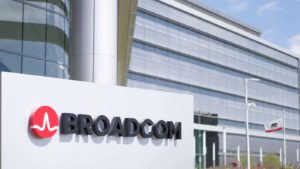
In the finance and tech space, hitting a trillion-dollar valuation is a mark of success, representing advancement, endurance and a strategic edge. Today, in the ongoing market volatility and geopolitical tensions, three stocks emerge as pre-trillion contenders. These companies may redefine the boundaries of corporate progression.
The first one, the semiconductor powerhouse, defies market turbulence with unwavering revenue growth, marking its dominance in an industry based on technological leaps. Meanwhile, the second one’s high rise in revenue signals market demand and its adeptness at capturing demand in emerging sectors like AI and networking infrastructure. And then there’s the third, led by Warren Buffett, a conglomerate that thrives on sharp investments and solid insurance underwriting. The company has embodied stability and long-term valuation growth for decades.
Read more to delve into the fundamentals of these pre-trillion-dollar giants. Learn about their strategic maneuvers and fundamental strengths that shift them towards unparalleled milestones and trillion-dollar glory.
TSMC (TSM)

TSMC’s (NYSE:TSM) top-line has strong growth despite fluctuations due to market adversities. In Q4 2023, the company delivered a consolidated top-line of NT$625.53 billion, marking a 14.4% sequential increase.
Additionally, year-over-year (YoY) revenue remained flat, reflecting endurance against unfavorable market states and geopolitical adversities (China-Taiwan). The constant revenue growth demonstrates TSMC’s solid market edge and fundamental capability to channel through industry adversity.
At the bottom line, TSMC has solid profitability metrics. This can be observed in its gross margin, operating margin, and net profit margin. In Q4 2023, the company obtained a gross margin of 53.0%, an operating margin of 41.6% and a net profit margin of 38.2%. While there was a slight decrease in gross margin sequentially, it remained healthy, reflecting TSMC’s efficient cost management. The company’s fundamental capability to sustain high margins suggests its operational and competitive edge.
Despite a sequential decline, TSMC yielded a diluted EPS of NT$9.21 for Q4 2023. This can be translated to approximately $1.44 per ADR unit. Moreover, the return on equity was 28.1%, indicating the company’s fundamental capability to generate massive returns. TSMC’s constant profitability and valuation creation breed its position as a high-value investment option in the semiconductor sector.
Fundamentally, TSMC’s tech moat can be observed in its adoption and ramp-up of cutting-edge process technologies. In Q4 2023, the company’s shipments of 3-nanometer, 5-nanometer, and 7-nanometer technologies drove considerable wafer revenue. Notably, advanced technologies, including 7-nanometer and more advanced nodes, contributed to 67% of total wafer revenue.
Overall, TSMC’s focus on advancements and continuous improvement in process technologies may lead to a $1 trillion mark in valuation, supported by its edgy performance.
Broadcom (AVGO)

Broadcom (NASDAQ:AVGO) delivers constant top-line growth. For instance, in Q4 2023, the company generated revenue of $9.3 billion, representing a 4% increase YoY. The growth suggests Broadcom’s fundamental capability to capture market demand and maintain a competitive edge in semiconductors and infrastructure software solutions.
Furthermore, the 2023 revenue reached a record $35.8 billion, marking 8% growth YoY. This sustained growth suggests solid performance and speaks to the sharp execution of AVGO’s business strategies. Looking ahead, Broadcom’s 2024 revenue outlook of approximately $50 billion marks a massive increase of 40% YoY. This guidance demonstrates the company’s prospects and its fundamental capability to capitalize on emerging market demand.
At its core, Broadcom’s top-line growth is driven by several factors, including investments in accelerators and network connectivity for AI by hyperscalers. Additionally, the acquisition of VMware may be transformational, further contributing to consolidated top-line growth.
Towards the bottom line, for 2023, Broadcom attained an adjusted EBITDA margin of 65%. Now, this represents the company’s constant profitability and operational edge. Looking ahead, the company provided 2024 guidance with an expected adjusted EBITDA margin of nearly 60% of projected revenue. Despite the slight decrease from 2023, this guidance reflects management’s confidence in maintaining solid profitability while accommodating anticipated top-line growth.
Overall, Broadcom’s fundamental capability to sustain healthy adjusted EBITDA margins represents its solid business fundamentals, effective cost controls and strategic management decisions. Hence, this suggests the company’s endurance and fundamental capability to adapt to changing market conditions while deriving value.
Berkshire Hathaway (BRK-B, BRK-A)

For Berkshire Hathaway (NYSE:BRK-A,NYSE:BRK-B), insurance businesses and related investments bring massive growth potential. This potency may uplift the company’s market valuation beyond $1 trillion.
Berkshire Hathaway maintains a solid investment portfolio diversified across asset classes. As of 2023, its fixed-maturity investments had hit $23.6 billion. These investments have a considerable concentration towards the U.S. Treasury, U.S. government corporations and agencies ($10.3 billion), foreign governments ($11.7 billion), and corporate bonds ($1.4 billion).
Despite minor unrealized losses in some categories, the overall portfolio attained stability and quality, with a critical presence of highly rated government and corporate securities. Similarly, Berkshire Hathaway has delivered constant earnings after tax (EAT) growth from insurance investment income. For instance, in 2023, EAT boosted by $3.1 billion (+47.5%), following a $1.7 billion (+34.9%) increase in 2022 compared to 2021.
This back-to-back growth is primarily based on higher short-term interest rates, leading to increased earnings from short-term investments. Such consistent growth in investment income also suggests Berkshire’s fundamental capability to capitalize on prevailing market conditions to boost its returns.
Moreover, the company’s insurance underwriting segment delivered considerable improvement in profitability. EAT from insurance underwriting reached $5.4 billion in 2023. The bottom line has rebounded from losses of $30 million in 2022 and eclipsed the positive earnings of $870 million in 2021. This improvement was based on several factors, including the relatively low losses from catastrophe events in 2023, improved underwriting results at GEICO, and the impact of premium rate increases coupled with lower claim frequencies.
Finally, adopting Accounting Standards Update (ASU) 2018–12 also led to higher earnings by retroactively adjusting previous years’ figures, indicating a strategic approach to financial reporting.
As of this writing, Yiannis Zourmpanos held a long position in TSM. The opinions expressed in this article are those of the writer, subject to the InvestorPlace.com Publishing Guidelines.




